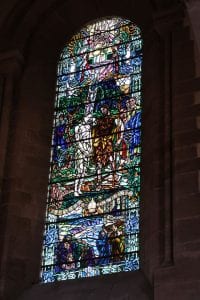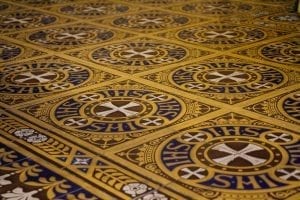Join us as we venture on a digital pilgrimage to a pivotal moment in the life and witness of the Scottish Episcopal Church.
Our virtual journey will take us to the East Coast of Scotland to discover more about the aftermath of penal laws against Episcopalians in the late 17th and 18th century and how Episcopal clergy and faithful laity, dispossessed, imprisoned and outlawed, defiantly continued to worship God.
We will visit a storehouse turned courtroom, meeting place, jail and now a museum, a ruined chapel with untold stories written on gravestones and a Church boldly living into the legacy of one of the defining moments in our story.
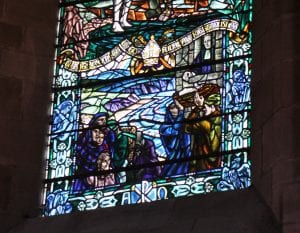
***
Our pilgrimage begins on the shore of Stonehaven bay where the Carron and the Cowie flow into the North Sea. Unlike in the image below (taken earlier this summer), the year is 1748.
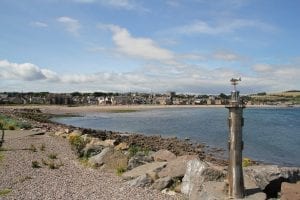
The defeat at Culloden just two years prior had seen a vast area of houses and farmsteads pillaged and destroyed, churches desecrated and burned, with people faring a worse fate still under the ruthless menace unleashed by the Duke of Cumberland and his men.
Over the preceding 60 years, six penal laws had sought to suppress Episcopal worship.
In 1690–1, the first penal law—the Act of Assembly—required all clergy to subscribe to the Westminster Confession.
In 1693–4, the second penal law—The Oath of Assurance— required all holding office to swear that William III is king in law and in fact.
In 1695, the third penal law—The Act to Forbid Deprived Episcopal Clergy—prevented Episcopal clergy from conducting marriages and baptisms.
In 1712, the fourth penal law—The Act of Toleration—required Episcopalian clergy to pray for Queen Anne by name and was the beginning of “qualified” congregations—the last of which was reunited with the Episcopal Church in 1920.
In 1745, the fifth penal law—The Toleration Act—required all Episcopal priests to register their Letters of Orders and take Oaths of Allegiance to King George II.
In 1748, the sixth penal law—The Penal Act—declared all previous registration of Orders to be void and Episcopal clergy were forbidden from conducting public worship. A priest was permitted to hold worship in a private house with not more than four people present, in addition to members of their family. Ingenious ways around the Act were devised—for example, the service might be conducted from a central hallway with not more than four people in each of the rooms leading from it, with others listening outside the windows.
In this world, three Episcopal priests were about to write their chapter in our story. Next, we visit Stonehaven Tolbooth and track some of its history spanning five centuries.
****
Blink, and you might miss the next stop of our pilgrimage—this humble rectangular building made of red sandstone hides within its walls over 400 years of history.
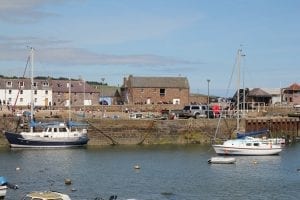
What is now known as the Stonehaven Tolbooth was initially built at the end of the 16th century as a storehouse for the fifth Earl Marischal during the construction of nearby Dunnottar Castle, making it the oldest building still in use in the town.
In 1600, Stonehaven became a county town and the storehouse perfectly suited a new role—that of the local courthouse and prison—for the next 167 years.
But before we get to the events of the 18th century, which many of you now anticipate, we will make a short stop in the late 1680s after the Glorious Revolution, when after the disestablishment of Episcopacy in Scotland, Episcopalians worshipped in the Tolbooth under Mr Peter Ross of Rose. But this wasn’t to last—the Episcopalians were associated with the Jacobite cause and discriminated against by the ruling Hanoverians.
In 1746, as the Duke of Cumberland was marching north to Aberdeen to ultimately face Bonnie Prince Charlie (the Young Pretender) at Culloden, his army burned and raised to the ground many Episcopal chapels, including those of Drumlithie and Muchalls, while the chapel in Stonehaven was gutted (its altar ending in a local inn) as setting it on fire would have endangered the buildings surrounding it.
The incumbent Episcopal priests thereafter held services in private houses and in the open air at secluded places. One Saturday night, the Rev John Troup of Muchalls sent word around the villages of Skateraw (now Newtonhill) and Seatoun of Muchalls that he would, on the following morning, conduct a service at a place called Goudie, a large rock situated a little to the north of Seatoun of Muchalls.
The next day, the congregation gathered there, the Skateraw people coming in their boats. The service had scarcely begun when the watchman, warned of soldiers approaching. Someone had informed the authorities. The Seatoun villagers scattered and the Skateraw people went home in their boats. John Troup escaped also, but it was clear that a congregation meeting in the open could no longer escape detection. A drystone chapel was built in a field above Muchalls Castle around 1748. A meeting place on the grounds of a friendly estate might have been less open to prying eyes.
However, during the winter of 1748–49, the Rev John Troup, the Rev Alexander Greig of Stonehaven and the Rev John Petrie of Drumlithie were imprisoned in Stonehaven Tolbooth for conducting services that were contrary to the penal law forbidding Episcopal worship with more than four people present. As this was the first time they were sentenced, they each received six months imprisonment—had it been a subsequent offence, they would have been transported to the American colonies for life.
And here is where the story might have ended and disappeared from the memory of our Church. But instead of giving up, even though they were jailed, the three priests still ministered to their flocks and even managed to perform baptisms but they—being contrary to the jailer’s instructions, could only be done by stealth.
The fishermen’s wives from Skateraw were often seen trudging along the sea-beach with their creels on their backs, in which were carefully concealed the babies that were to be secretly presented at the baptismal font. After wading through the conjoined streams of the Carron and the Cowie which could only be done during low tide, they had to clamber a considerable distance among rugged rocks before reaching the backstair of the Tolbooth where they had to watch for a favourable opportunity of approaching the cell of their priest. After the child was baptised, the mother, again carefully depositing it in her creel, returned by the same route.
On their liberation from prison, the priests returned, too, to their homes and preached in private houses until the advent of quieter times.
These events were later memorialised forever in “Baptism from Stonehaven Jail”, George Washington Brownlow’s painting from 1865 now in St Paul’s Cathedral, Diocese of Brechin, Dundee.
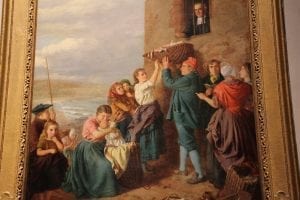
The Tolbooth has survived more than its fair share of history—in 1944 a mine exploded at the nearby pier and badly damaged the ancient building, but by 1963 it was reconstructed and reopened through the cooperation of the National Trust for Scotland, the Representative Church Council of the Scottish Episcopal Church, the Historic Buildings Council, the Dalrymple Trust and many individual donors as a museum. Today, it is a Grade A listed building.
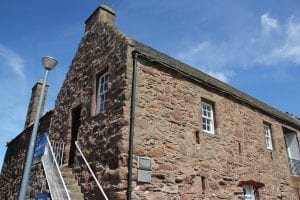
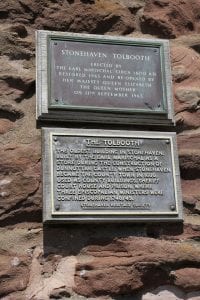
Next, we visit the ruined chapel of Our Lady of the Storms and St Nathalan, the final resting place for many Episcopalians, including the Rev John Troup.
***
Perched atop the cliffs where the Highland Boundary Fault meets the North Sea, opposite the Tolbooth, on the far side of Stonehaven Bay stand the roofless ruins of the 13th-century Cowie chapel, known locally as St Mary of the Storms.
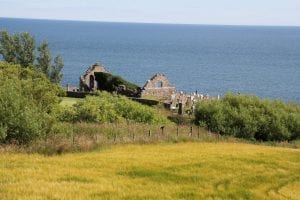
The circular churchyard traditionally marks the site where an earlier chapel was established by St Nathalan, sometime in the 7th century.
The Chapel of St Mary and St Nathalan is one of the oldest surviving structures in Kincardineshire. Several Scottish monarchs, in particular James IV, frequently worshipped here.
Many legends surround the building—from St Nathalan’s treasure buried in the churchyard to the building’s stones cursed if ever taken away from the church.
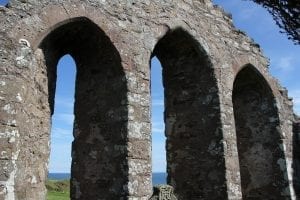
The chapel fell into disuse soon after the Reformation. It is recorded that it “was unroofed by the ecclesiastical authority on account of certain scandals”.
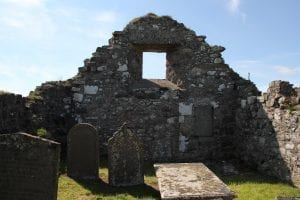
But our pilgrimage is not over yet. Not far from the seaward wall is a group of tombstones that commemorates priests of the Scottish Episcopal Church. One of these stones marks the final resting place of the Rev John Troup of Muchalls, who died in 1776.
Another Episcopal story is told by the names on many of the tombstones—Christie, Lees, and Masson. In “Baptism from Stonehaven Jail”, George Washington Brownlow used members of these families from Skateraw as models. Some of them and their families now rest in the chapel’s graveyard.
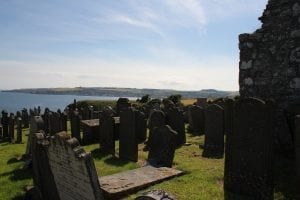
***
As our digital pilgrimage to our sister Diocese Of Brechin comes to an end, we reflect on our experiences in prayer.
God who sees us,
You are ever-present in our lives through scripture and story and the works of your saints, those remembered by us and those known only to you.
Fill our hearts with joy and curiosity for your world, so as we wander your creation we may ever marvel at the wonders you have made.
Remind us that your mercy is wider, your goodness is stronger, and your love is bigger than our own presumptions.
In you, all things are possible, through Jesus Christ who travelled with our ancestors and travels with us now, and is alive and reigns with you and the Holy Spirit, one God, now and for ever.
Amen.
